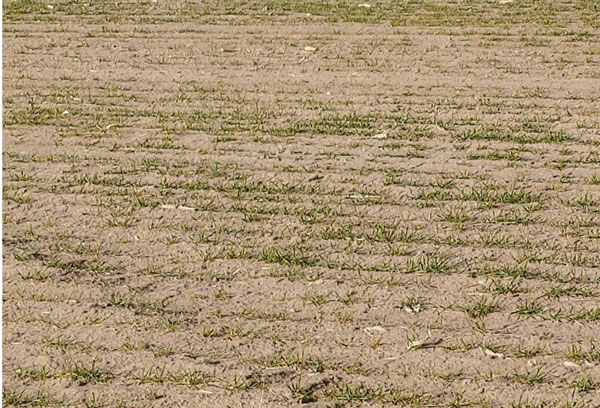Prolonged drought in much of Kansas has resulted in marginal wheat stands and a difficult decision for many farmers, especially with reasonably strong prices.
On one hand, wheat did not have many fall tillers form and is heavily reliant on spring tillers (Figure 1). This will likely result in slow canopy closure and will give weeds a chance to become established. Because of this, thin wheat stands will require residual herbicides to limit competition from weeds. On the other hand, if a wheat field with a poor stand might be planted to another crop this spring, some residual herbicides will limit options for a subsequent crop.

Figure 1. Thin wheat stand in northwest Kansas. Photo by Jeanne Falk Jones, K-State Research and Extension.
Some residual herbicides that can be applied to wheat before jointing are listed in Table 1, along with their half-lives and replant intervals for corn and sorghum.
Table 1. Residual herbicides, field half-lives, and crop rotation intervals.
|
Herbicide |
Rate |
Half-life (days) |
Rotation interval (corn) |
Rotation interval (sorghum) |
Comments |
|
Ally |
0.1 oz |
13 |
12 months |
4 months |
Apply with MCPA after 2-leaf, apply with 2,4-D after tillering |
|
Amber |
0.28 to 0.47 oz |
39 |
4 to 36 months |
14 to 24 months |
|
|
Dicamba |
2 to 4 fl oz |
4 |
22 days per pint applied |
22 days per pint applied |
|
|
Everest |
2 oz |
12 |
11 months |
18 months |
|
|
Metribuzin |
2 to 10 oz |
19 |
30 to 120 days |
18 months |
Varieties vary in tolerance |
|
Prowl H2O |
1.5 to 3.0 pts |
101 |
0 days |
10 months |
Rainfall or irrigation required for incorporation |
Some additional herbicide premixes are available. All products will require some precipitation or irrigation for incorporation into the zone of weed seed germination. In addition, some products (i.e., dicamba, metsulfuron, Ally) have postemergence activity. It is important to know adjuvant requirements. Some products can be applied with UAN, while others cannot. Because of this, check labels for guidance.
For more detailed information, see the “2023 Chemical Weed Control for Field Crops, Pastures, and Noncropland” guide available online at https://bookstore.ksre.ksu.edu/pubs/SRP1176.pdf or check with your local K-State Research and Extension office for a paper copy.
The use of trade names is for clarity to readers and does not imply endorsement of a particular product, nor does exclusion imply non-approval. Always consult the herbicide label for the most current use requirements.
Sarah Lancaster, Weed Management Specialist
slancaster@ksu.edu
Jeanne Falk Jones, Multi-County Agronomist
jfalkjones@ksu.edu